1 实验目的
探索、理解并掌握操作系统同步机制的设计和实现机理, 针对所谓的银行账户转账同步问题,构建基于 Peterson 算法的同步解决方案以及基于 Windows(或 Linux) 操作系统同步机制(主要是互斥机制) 的解决方案,并进行分析和比较。
2 实验内容
针对所谓的银行账户转账同步问题, 分析、设计和利用 C 语言编程实现基于 Peterson 算法的同步解决方案,以及基于 Windows(或 Linux)操作系统同步机制的相应解决方案,并就自编同步机制与操作系统自身同步机制的效率进行比较和分析。
3 实验要求
同步机制及应用编程实现与比较实验功能设计要求:
(1) 银行账户转账同步问题的抽象及未采取同步控制情况下的编程实现;
(2) 基于 Peterson 算法的银行账户转账同步问题解决方案;
(3) 基于 Windows(或 Linux)操作系统同步机制的银行账户转账同步问题解决方案;
(4) Peterson 算法同步机制和 Windows(或 Linux)操作系统同步机制的效率比较。这里,银行账户转账假定为两个账户 nAccount1、 nAccount2(均定义为初值是 0 的整型全局变量) 之间进行,一个转出、一个转入,转账金额随机产生。整个程序共设立该两个账户之间的转账线程两个,且线程功能设计逻辑完全一致,不妨设转账线程的主体逻辑结构为如下的循环:
int nLoop = 0; int nTemp1, nTemp2, nRandom; do { nRandom = rand(); nTemp1 = nAccount1; nTemp2 = nAccount2; nAccount1 = nTemp1 + nRandom; nAccount2 = nTemp2 - nRandom;2 nLoop++; } while ((nAccount1 + nAccount2) = = 0);
注意,在基于 Peterson 算法或 Windows(或 Linux)操作系统同步机制的银行账户转账同步问题解决方案中,上面的循环结束条件应修正为:while(nLoop < 1000000); 或 while(nLoop < 5000000);同时在该循环体中 nAccount2 = nTemp2 - nRandom;语句后插入如下条件语句:if (nAccount1 + nAccount2 != 0) break;
4 实验步骤
4.1 实验环境
| 操作系统 | 5.4.18-1-MANJARO |
|---|---|
| 编译器 | gcc 版本 9.2.0 (GCC) |
4.2 未采取同步控制情况
主函数如下,使用pthread_cread函数创建线程,pthread_join函数回收线程资源。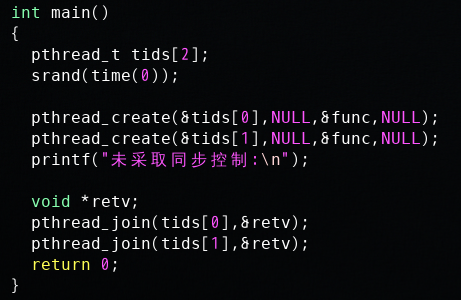
线程函数如下,Nloop记录循环次数,nAccount储存两个银行账户的金额,pthread_self()获取当前线程的tid,而使用pthread_exit函数退出线程。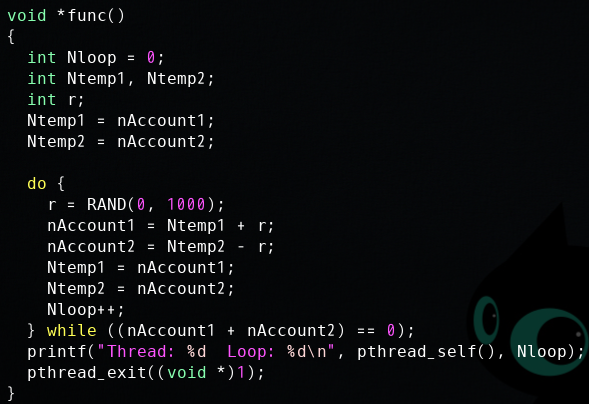
运行结果如下:
4.3 基于 Peterson 算法的同步
通过设置flag和turn来实现多线程银行转账同步。当另一线程的flag为真且turn指向另一线程则当前线程阻塞。
两个子线程函数如下,通过while空循环实现阻塞。同时为了与Linux互斥锁机制效率进行比较,调用gettimeofday()函数储存线程运行时间。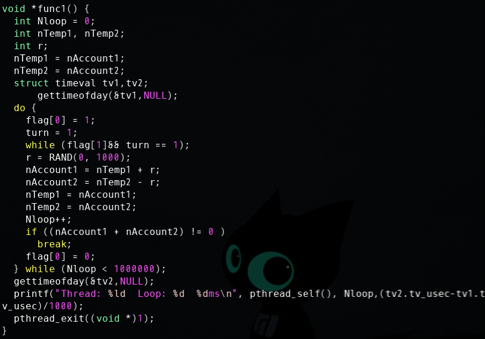
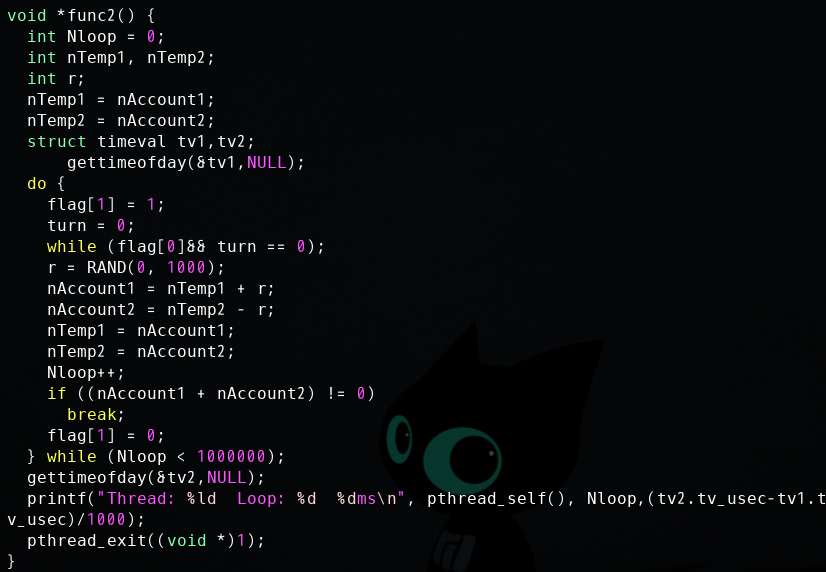
运行结果如下: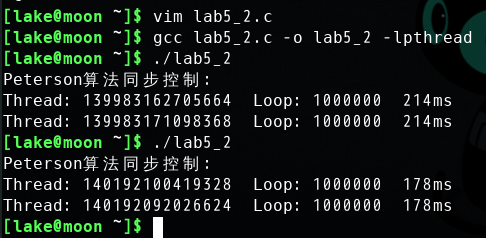
4.4 基于 Linux互斥锁的同步
互斥锁本质就是一个特殊的全局变量,拥有lock和unlock两种状态,unlock的互斥锁可以由某个线程获得,一旦获得,这个互斥锁会锁上变成lock状态,此后只有该线程由权力打开该锁,其他线程想要获得互斥锁,必须得到互斥锁再次被打开之后。Linux中互斥锁全局变量如下:
子线程函数func如下,通过pthread_mutex_lock()函数锁定互斥锁。使用临界资源后使用pthread_unlock()函数释放互斥锁。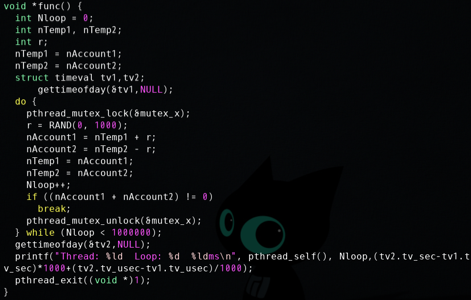
运行结果如下:
5 Peterson算法与Linux互斥锁比较
Peterson算法和Linux互斥锁都是一种很好很简便的控制线程同步机制。对于临界资源有很严格的控制。从运行的结果来看,Peterson算法和Linux互斥锁都能实现并发线程同步。但是通过两者的运行时间来看,两种机制效率是不同的,相较而言Pterson算法的效率更高一筹,而Linux互斥锁机制略逊于Pterson算法。
6 实验总结
本实验研究了多线程同步机制及模拟银行转账进行应用编程。通过银行转账分别模拟了未采取同步机制、基于peterson算法的同步机制和基于Linux互斥锁的同步机制。并将基于peterson算法的同步机制与基于Linux互斥锁的同步机制二者效率进行了比较。通过模拟未采取同步机制的银行转账过程,我们深刻的理解了线程同步的重要性。剩下两个实验让我们对peterson算法有了更深的理解,并且对Linux互斥锁机制有所了解。这对理解操作系统线程控制措施有所促进。就实验难度而言,主要集中于对Linux平台的c编程技能上,当然很多API网上有很多教程和实例,这降低了实验难度。
7 实验源码
// 未采取控制措施#include<pthread.h>#include<stdio.h>#include<stdlib.h>#include<string.h>#include<unistd.h>#include<time.h>#define RAND(x,y) (rand()%((y)-(x)+1)+x)int nAccount1 = 0,nAccount2=0;void *func(){int Nloop = 0;int Ntemp1, Ntemp2;int r;Ntemp1 = nAccount1;Ntemp2 = nAccount2;do {r = RAND(0, 1000);nAccount1 = Ntemp1 + r;nAccount2 = Ntemp2 - r;Ntemp1 = nAccount1;Ntemp2 = nAccount2;Nloop++;} while ((nAccount1 + nAccount2) == 0);printf("Thread: %ld Loop: %d\n", pthread_self(), Nloop);pthread_exit((void *)1);}int main(){pthread_t tids[2];srand(time(0));pthread_create(&tids[0],NULL,&func,NULL);pthread_create(&tids[1],NULL,&func,NULL);printf("未采取同步控制:\n");void *retv;pthread_join(tids[0],&retv);pthread_join(tids[1],&retv);return 0;}
// peterson算法#include<pthread.h>#include<stdio.h>#include<stdlib.h>#include<string.h>#include<unistd.h>#include<time.h>#include<sys/time.h>#define RAND(x,y) (rand()%((y)-(x)+1)+x)int nAccount1 = 0,nAccount2=0;int flag[2] = { 0,0};int turn = 0;void *func1() {int Nloop = 0;int nTemp1, nTemp2;int r;nTemp1 = nAccount1;nTemp2 = nAccount2;struct timeval tv1,tv2;gettimeofday(&tv1,NULL);do {flag[0] = 1;turn = 1;while (flag[1]&& turn == 1);r = RAND(0, 1000);nAccount1 = nTemp1 + r;nAccount2 = nTemp2 - r;nTemp1 = nAccount1;nTemp2 = nAccount2;Nloop++;if ((nAccount1 + nAccount2) != 0 )break;flag[0] = 0;} while (Nloop < 1000000);gettimeofday(&tv2,NULL);printf("Thread: %ld Loop: %d %dms\n", pthread_self(), Nloop,(tv2.tv_usec-tv1.tv_usec)/1000);pthread_exit((void *)1);}void *func2() {int Nloop = 0;int nTemp1, nTemp2;int r;nTemp1 = nAccount1;nTemp2 = nAccount2;struct timeval tv1,tv2;gettimeofday(&tv1,NULL);do {flag[1] = 1;turn = 0;while (flag[0]&& turn == 0);r = RAND(0, 1000);nAccount1 = nTemp1 + r;nAccount2 = nTemp2 - r;nTemp1 = nAccount1;nTemp2 = nAccount2;Nloop++;if ((nAccount1 + nAccount2) != 0)break;flag[1] = 0;} while (Nloop < 1000000);gettimeofday(&tv2,NULL);printf("Thread: %ld Loop: %d %dms\n", pthread_self(), Nloop,(tv2.tv_usec-tv1.tv_usec)/1000);pthread_exit((void *)1);}int main(){pthread_t tids[2];srand(time(0));pthread_create(&tids[0],NULL,&func1,NULL);pthread_create(&tids[1],NULL,&func2,NULL);printf("Peterson算法同步控制:\n");void *retv;pthread_join(tids[0],&retv);pthread_join(tids[1],&retv);return 0;}
// Linux互斥锁机制#include<pthread.h>#include<stdio.h>#include<stdlib.h>#include<string.h>#include<unistd.h>#include<time.h>#include<sys/time.h>#define RAND(x,y) (rand()%((y)-(x)+1)+x)int nAccount1 = 0,nAccount2=0;pthread_mutex_t mutex_x=PTHREAD_MUTEX_INITIALIZER;void *func() {int Nloop = 0;int nTemp1, nTemp2;int r;nTemp1 = nAccount1;nTemp2 = nAccount2;struct timeval tv1,tv2;gettimeofday(&tv1,NULL);do {pthread_mutex_lock(&mutex_x);r = RAND(0, 1000);nAccount1 = nTemp1 + r;nAccount2 = nTemp2 - r;nTemp1 = nAccount1;nTemp2 = nAccount2;Nloop++;if ((nAccount1 + nAccount2) != 0)break;pthread_mutex_unlock(&mutex_x);} while (Nloop < 1000000);gettimeofday(&tv2,NULL);printf("Thread: %ld Loop: %d %ldms\n", pthread_self(), Nloop,(tv2.tv_sec-tv1.tv_sec)*1000+(tv2.tv_usec-tv1.tv_usec)/1000);pthread_exit((void *)1);}int main(){pthread_t tids[2];srand(time(0));pthread_create(&tids[0],NULL,&func,NULL);pthread_create(&tids[1],NULL,&func,NULL);printf("Linux互斥锁同步控制:\n");void *retv;pthread_join(tids[0],&retv);pthread_join(tids[1],&retv);return 0;}

